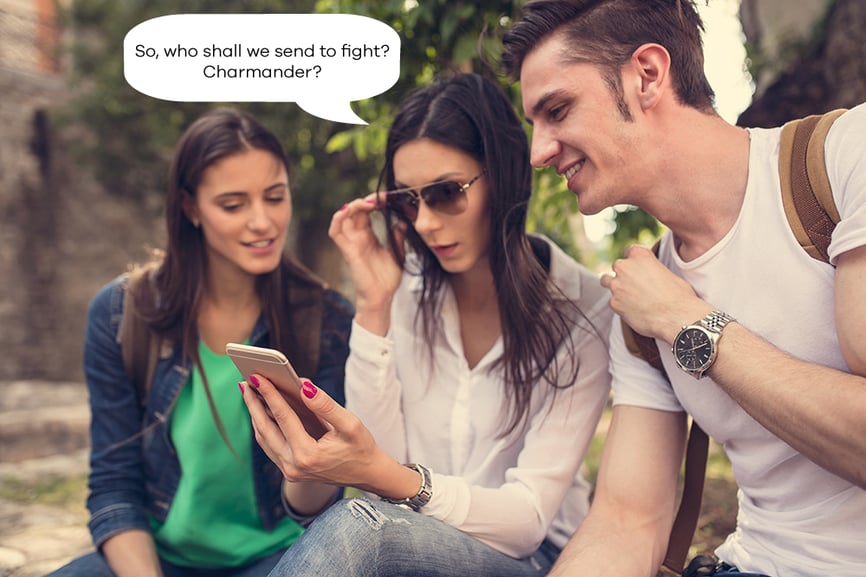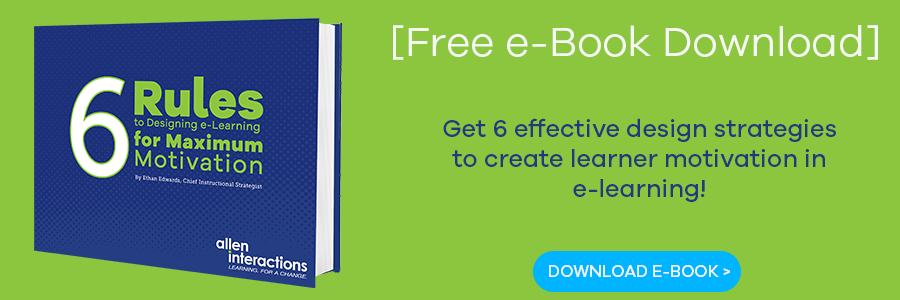Blog
5 Instructional Design Insights from The Marshmallow Test: Part 2
By Edmond Manning, Senior Instructional Strategist Surely you’ve heard the news stories. Pokémon Go players lured to robberies or stepping blindly ...


Pokémon Go: 3 Lessons for Instructional Designers
By Edmond Manning | July 21, 2016 | Custom Learning | 0 Comments
 By Edmond Manning, Senior Instructional Strategist
By Edmond Manning, Senior Instructional Strategist
Surely you’ve heard the news stories.
Pokémon Go players lured to robberies or stepping blindly into traffic. On Facebook, I read a friend’s post describing how her car was rear-ended at a stoplight. Yes, the driver was playing Pokémon Go. Yes, he confessed this to the police, alleviating my friend from any responsibility. A Florida news anchor walked right into the live weather forecast, too busy catching imaginary animals to pay attention.

A dozen articles appear daily. I’m amused by the shock in these online articles, openly exclaiming, who could have possibly foreseen such consequences?
Well, the game developers.
They should have.
Maybe they did, too. The parent company, Nintendo, certainly isn’t going to publish a warning such as: Playing this game may lead to you being robbed at gunpoint. But I am willing to gamble—much of their newfound profits—they discussed consequences.
As developers of training, whether it’s e-learning or otherwise, we must consider consequences for our training. We should consider what learners might take away and what they may not. What experience they have. Training sponsors only want one outcome: for employees to change behavior. As instructional designers, it’s our job to consider consequences beyond the intended.
Let’s explore what we can learn from this Pokémon Go phenomenon.
Lesson 1: When motivated, people don’t need much training.
Michael Allen says:
Motivation is essential; without it, learning doesn’t happen. So designers should begin by addressing motivation. If you have budget left over after achieving an effective level of motivation, you can go on to create learning experiences. But you can’t skip over motivation and expect to improve performance.
Well said.
Who is paying all of these seekers to spend their free time chasing down Pokémon? Nobody.
Yesterday afternoon, I joined a colleague for a Pokémon break. She showed me how the game worked on her phone. You spot a Pokémon that is available and an indicator reveals whether the creature is one, two, or three “steps” away.
“A step,” she explained, “does not mean a step. It means a quantity of distance that is not defined. Obviously, things that are one step are close, maybe only 100 feet. Three steps are further away.”
I said, “So, three hundred feet.”
“Maybe,” she replied. “It’s less defined than that. Could be closer. Or farther.”
My questions about this game were not met with satisfactory answers.
How do you know what a “step” is? “You just to have feel it out.”
Does everyone call them steps even though they aren’t steps? “That’s what we call them among our circle of friends.”
Where are the instructions? “The instructions are five screens that you see when you first open the app, and they never show up again.”
Imagine releasing training where terms are not defined, physical distances are deliberately vague, and there are almost no instructions on how to complete the ambitious interactivity. Yet, instead of being a public relations nightmare, Pokémon Go is a global phenomenon.
If you think your content is more important than learner motivation, you’re mistaken. This error in perspective will result in very little behavior change. Ask yourself and your team a few hard questions about learner motivation:
-
How eager are they to solve problems? (Be honest. “Not very” is a legitimate answer.)
-
Who is performing the behavior flawlessly? What do THEY say their motivation is?
-
Think about the last ten interactions you’ve had with your learner audience. What riled them up? What got them excited? (The answer may not be related to your training content.)
-
What happens to those who do not perform as desired? Do they keep their jobs? Are there any consequences? If there are none, be honest about that. You need that honesty to uncover motivation issues.
Lesson 2: Taking advantage of social opportunities requires forethought.
Pokémon Go developers made interesting choices when creating opportunities for interaction. You know where you’re likely to find a whole mess of Pokémon hanging out or necessary extras to continue playing? Public parks.
Why public parks?
Because they wanted a non-traffic environment providing the opportunity to talk. Relax. Play. Earlier this week, my boss was on a business trip in our nation’s capital, Washington, D.C. She entered a park because she needed more incense and Poké-balls. (Don’t ask.) A woman in a power business suit was leaving and said to my boss, “You’ll find them over there.”
They chuckled together.
For a split second, these two were connected, hunters thrilled by the chase.
A number of clients come to us expressing the desire to take advantage of social media and the excitement of a random, positive interaction. Thrilled by the possibility of using Facebook or Twitter, they want their own learners to gush and hashtag in their free time. Unfortunately, a typical conversation about using social media goes like this:
Us: Learners could use this space to share best practices.
Client: Oh, no. We don’t want them to do that. Some of them might share terrible ideas.
Us: Well, if you’re worried about that, you’d need a moderator to filter each comment and responses to comments. Or possibly a way to upvote and downvote comments. There are other possibilities.
Client: No, we don’t want an opinion expressed that we didn’t provide. We’re not doing that. So. How else can we force them to go online and generate conversation?
Us: …
If you want learners to engage social media, you must allow for unforeseen consequences. People will talk. Argue. Debate. Someone will want extra attention. Some people will be helpful; others will not. You get the show-offs alongside the helpers.
Moderated social media can reduce unforeseen consequences, but that requires resources and careful attention. There are incredible advantages to learners jumping into each other’s lives. My boss was completely charmed by the business executive who said, “Check over there.”
If you’re considering social opportunities for training, ask yourself a few questions:
-
How much freedom will you permit for learner interaction? How much will your regulatory group permit? Legal? Corporate executives?
-
What if learners interact in a way you did not anticipate? How will you address it?
-
Where (with which medium) do you anticipate learners will interact? What if the conversation spills out to another social media or another format?
-
Forced interaction is very different than spontaneous interaction (see motivation). To harness the inherent advantages in social media, what will you do to generate interest in spontaneous interaction?
Lesson 3: Learner experience is an instructional issue.
When searching the Internet for Pokémon Go news-related articles, why aren’t there any front-and-center links about the clumsy interface design? Citizens of the Internet like to complain. Where are all the complaints?
An online review of the game by The Guardian summarizes the issue nicely, right in the headline: Pokémon Go review – it may not be a good game, but it's a great experience.
The experience is everything.
Nintendo banked (literally, banked) the success of this project on a highly desirable repeat experience. It’s not satisfying to catch just one Pokémon. You’ve got to catch many, many more. One colleague of mine drove twenty minutes away for the possibility of a rare find. When I asked what made this game-play fun, she said, “Oh, the sounds. The way they growl and wiggle on the ground. The satisfaction of capturing one and the animation that accompanies it. The thrill of seeing your skill level grow, as you wonder if you’re ready to do battle with another Pokémon.”
I didn’t understand most of that, but the point is, the experience was comprehensive. She could list things she loved, but the overall experience mattered.
We don’t talk about the experience enough in our field.
Yes, the content is covered, scenarios are generated. Quiz questions written based on industry best practices. Yawn. But what was the learner experience? Were the learners engaged throughout? Did they describe the experience to colleagues? Would they return to it again and again? My personal theory is that learners don’t return to training experiences because it’s not an experience—it’s usually just a reading assignment.
Questions for instructional designers to ask:
-
Are we designing training to cover content or for a learner experience?
-
What is the learners’ comprehensive experience? How does it relate to the performance gap?
-
How do we measure and validate the overall learner experience?
-
What are we willing to do (i.e. change) if the learner experience is not a good one?
Power Up
The sudden, insane popularity of this augmented reality game leaves us with a lot to ponder. It’s changing real-world behavior. As people who are interested in the forces that change behavior, we should apply our instructional design lens and study the lessons it offers.
In addition, if you take interest in our industry’s fascination with gamification (or, as I prefer, gameful design), the structure of the game itself and the relationship to other players is fascinating. It doesn’t matter if you play Pokémon Go or are completely turned off—there are insights to be mined, whatever your perspective.
Pokémon Go offers a peek at me—my own instructional design relationship to gameful design and motivation. I can learn more about my perception of a “valuable experience,” interface design cues, and what is considered gaming. And if you are curious, it also offers a (wait for it…) Pikachu.
LIKE WHAT YOU'VE READ? SHARE THIS BLOG USING THIS READY-MADE TWEET!
CLICK TO TWEET: The #PokémonGO Phenomenon Offers Three Lessons for #InstructionalDesigners http://hubs.ly/H03HlXR0 #aiblog @customelearning

About the Author: Edmond Manning
Edmond Manning, senior instructional designer for Allen Interactions, has more than 20 years designing interactive e-learning experiences on instructional topics including: software simulation, medical ethics, supervisory skills, and selling/presentation skills, and gosh, a whole bunch of others. He has helped mentor and grow e-learning departments, worked as a business consultant, independent contractor, and instructed the ATD e-Learning Instructional Design Certificate Program for more than a decade. Edmond has a master's degree from Northern Illinois University in instructional technology.
Comments
Would you like to leave a comment?
Related Blog Posts

By: Edmond Manning | Jun, 2017
Category: Custom Learning

Blog
5 Instructional Design Insights from The Marshmallow Test: Part I
By Edmond Manning, Senior Instructional Strategist Surely you’ve heard the news stories. Pokémon Go players lured to robberies or stepping blindly ...
By: Edmond Manning | Jun, 2017
Category: Custom Learning

Blog
11 Instructional Design Truths According to Cat .gifs
By Edmond Manning, Senior Instructional Strategist Surely you’ve heard the news stories. Pokémon Go players lured to robberies or stepping blindly ...
By: Edmond Manning | Oct, 2019
Category: Custom Learning

